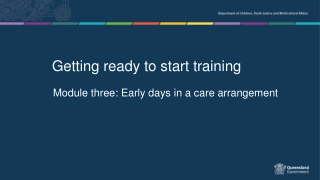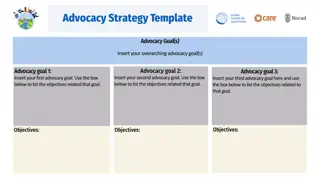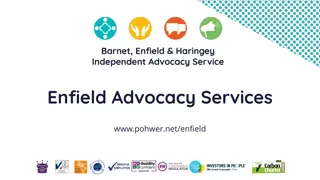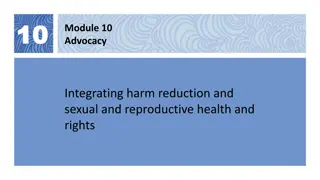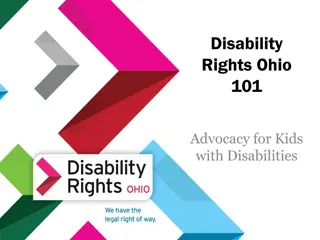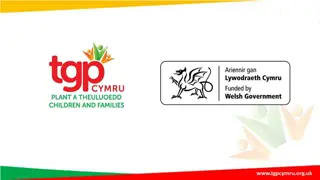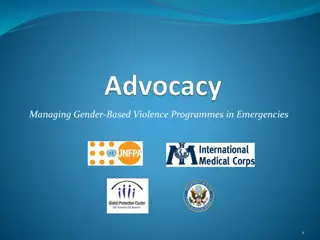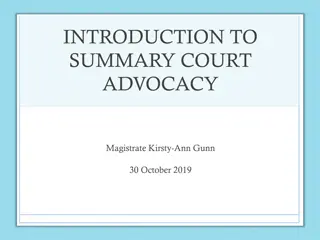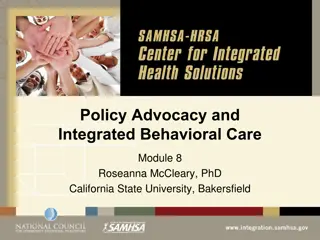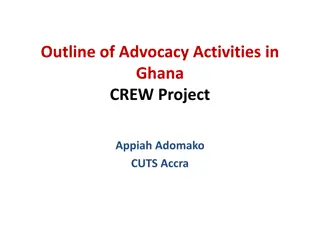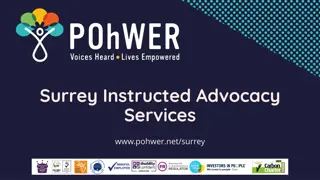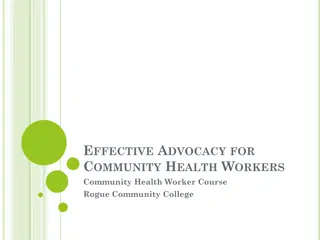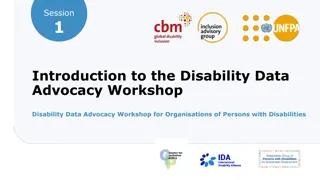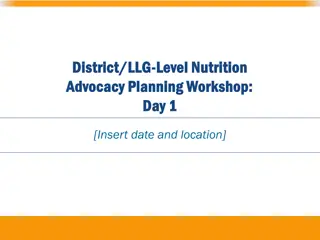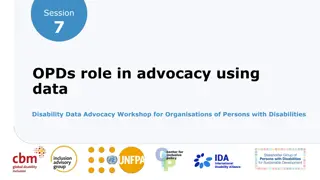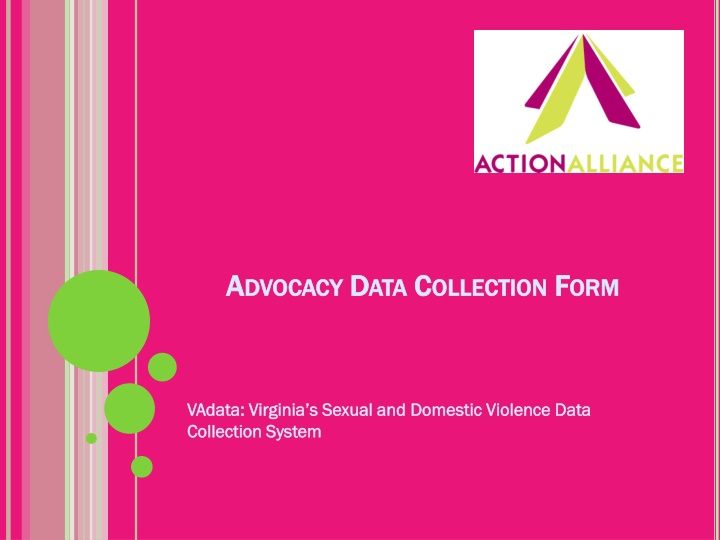
Participant Codes in Advocacy Data Management
Learn about participant codes, their importance, and how they protect identities in advocacy services. Discover why using participant codes is crucial for confidentiality and compliance with legal requirements.
Download Presentation

Please find below an Image/Link to download the presentation.
The content on the website is provided AS IS for your information and personal use only. It may not be sold, licensed, or shared on other websites without obtaining consent from the author. If you encounter any issues during the download, it is possible that the publisher has removed the file from their server.
You are allowed to download the files provided on this website for personal or commercial use, subject to the condition that they are used lawfully. All files are the property of their respective owners.
The content on the website is provided AS IS for your information and personal use only. It may not be sold, licensed, or shared on other websites without obtaining consent from the author.
E N D
Presentation Transcript
A ADVOCACY DVOCACY D DATA ATA C COLLECTION OLLECTION F FORM ORM VAdata: Virginia s Sexual and Domestic Violence Data VAdata: Virginia s Sexual and Domestic Violence Data Collection System Collection System
W WHAT HAT IS IS AN AN A ADVOCACY DVOCACY C CONTACT ONTACT? ? An advocacy contact is any face-to-face crisis/support service that you provided to a victim, family/friend of victim, parent/guardian of victim, or perpetrator. You will use the Advocacy form face-to-face, direct services provided to all adults and children. Advocacy form to record And yes, children should have separate advocacy records from their parents if you are providing direct services to them. separate
HOW DOES THE ADVOCACY FORM WORK? The Advocacy Form works more like a file than a form, meaning that each person receives ONE participant code participant code for all services received, and services should be tracked under that code. ONE The participant s record, once created, is then updated based on any new information learned and/or new services provided by adding new sheets for each additional service or service contact. Users can run reports and view past records of services received by a person using their participant code code. participant
WHAT IS A PARTICIPANT CODE? A participant code participant code is a unique set of alpha-numeric characters that your agency assigns to a person receiving advocacy services to track unduplicated (different) people who are served by your agency. Only your agency should know your system for creating participant codes or be able to link a person to their participant code.
WHY DO WE USE A PARTICIPANT CODE? We use a participant code to protect the identity of the people we serve. The participant code allows you to track the number of people you serve without using personally identifying information information, or P.I.I P.I.I., such as name, social security number, birthdate, etc. personally identifying Using personally identifying information in a data collection system, especially a web-based system, can create safety risks and violate one s privacy and confidentiality. To do so is also in direct violation of To do so is also in direct violation of VAWA (Violence Against Women Act), which explicitly VAWA (Violence Against Women Act), which explicitly states that this is not permitted, as well as VOCA and states that this is not permitted, as well as VOCA and FVPSA requirements. FVPSA requirements.
THINGS TO KNOW ABOUT CREATING CODES Local agencies are responsible for developing their own participant code creation system. The coding system should never whole) personally identifying information such as names or initials, social security numbers, date of birth, etc. never include (in part or in All staff within an agency need to use the same code creation system logic. An individual s participant code should remain the same for their entire service period entire service period (this includes children who, over time, may also receive services as adults). DO DO NOT assign new NOT assign new participant codes to people who return to your agency for services, even if people who return to your agency for services, even if several months or years have gone by. several months or years have gone by. participant codes to
THINGS TO KNOW ABOUT CREATING CODES A code creation system can be as simple or as complex as your agency needs. Some agencies use a simple numeric system, such as 0001, 0002, 0003, etc. Other agencies use a combination of letters or numbers which may help identify how a person came to receive services from their agency, such as S0001 for people who came via the shelter, or ER0001 for those who may have come via an emergency room accompaniment. Codes are case insensitive. case insensitive. Codes are Participant codes for children of clients should follow a similar convention used for the parent record, but adding a, b, c, etc. to the end to indicate a familial connection (0001a, 0001b, 0001c, for client 0001 s three children)
INFORMATION IN AN ADVOCACY RECORD Each advocacy record includes 8 8 different sections: Information About Person Served Presenting Sexual Violence Experience Presenting Domestic Violence Experience Other Presenting Experience Services and Referrals Shelter Services Housing Stabilization (which is for use with the HMIS- comparable data fields and other HUD reporting) VSTOP supplemental information
INFORMATION IN AN ADVOCACY RECORD Services that are provided through VSTOP require that the VSTOP supplemental information is completed. Supplemental information is no longer required for Supplemental information is no longer required for Victim Fund services. Victim Fund services. If your program utilizes any of the Housing Stabilization reports for HUD reporting or the HMIS data elements, a Housing Stabilization sheet will need to be completed. For more on the HMIS comparable data elements, see Module 9: Housing Stabilization Module 9: Housing Stabilization and HMIS and HMIS
INFORMATION ABOUT PERSON SERVED SHEET: This part of the record contains demographic information on the person receiving services. Required fields on the Information About Person Served sheet to submit an Advocacy Record are: Date Staff Name Gender Race/Ethnicity (you can select unknown) Approximate Age Approximate Age of the Victim at Earliest Victimization [if the person had multiple victimizations at different ages, you will need to determine the person s age at the time of the very first victimization very first victimization even if the same victimization type occurred multiple times, different victimization types occurred over time, and/or the person did not disclose the victimization(s) until years after] Locality (you can select unknown) Referral Source (you can select unknown) History of Violence Experienced
INFORMATION ABOUT PERSON SERVED SHEET: The Information About Person Served tab also allows you to record information on the different types of violence a person may have experienced throughout their lifetime. If you are providing services to someone who has not experienced sexual and/or domestic violence, or has experienced a different type of violence, you can record this in the Other Reason for Advocacy-Non SV/DV Related or under the Other section of the Information on Person Served tab.
All Advocacy Forms require at least one experience sheet to be completed. As a reminder, a new Presenting Sexual Violence Presenting Sexual Violence sheet should be completed for EACH experience of sexual violence. If there are multiple perpetrators, each is a separate experience and should be entered on separate sheets. a new Presenting Domestic Violence Presenting Domestic Violence sheet only needs to be entered if there is a NEW relationship/perpetrator at least one presenting We understand that the nature and definition of domestic violence is that there is a pattern of behaviors pattern of behaviors that cause harm and hurt. One presenting domestic violence experience sheet can represent the total experience. A new Other Presenting Violence Other Presenting Violence sheet can be created to better illustrate instances of sexual or domestic violence, OR it can be used to tell about the experiences of a person who has NOT NOT experienced sexual or domestic violence.
INFORMATIONABOUT PERSON SERVED SHEET: It is expected that information on this sheet is static and does not change often. Unlike the other four tabs, this one only allows one sheet of information to be stored. You can, however, update the information on this tab as needed (such as updating demographics or age), but you cannot add additional sheets here. Next, you will need to enter a sheet on either the Presenting Sexual Violence Presenting Sexual Violence, Presenting Domestic Violence Violence, or Other Presenting Experience tab. Other Presenting Experience tab. If a person is receiving services for multiple victimizations, complete as many sheets on the corresponding tabs as necessary. Presenting Domestic
PRESENTING SEXUAL VIOLENCE SHEET: This is the part of the record where you will record information on each presenting sexual violence sexual violence experience that is reported to you. Specific information about each sexual violence experience is recorded separately by adding a new sheet to this section. For example, if a person was sexually abused as a child and then again in college, you would create two presenting experiences sheets for this survivor s record.
PRESENTING SEXUAL VIOLENCE SHEET: If there is a presenting sexual violence experience, the following fields are required: Date Staff Name Description of Person Receiving Services Type of Sexual Violence Relationship of Perpetrator to Victim (unknown option is available) Please note: all other perpetrator information is optional need only be included if known. Do not make up information to include here if it is unknown. include here if it is unknown. optional and . Do not make up information to If there is no presenting sexual violence experience, you can skip this tab altogether.
PRESENTING DOMESTIC VIOLENCE SHEET: This is the part of the record where you will record information on each presenting domestic violence domestic violence experience that is reported to you. Specific information on each domestic violence experience is recorded separately by adding a new sheet to this section. It is important to note, that in domestic violence situations, it would only be considered a new presenting incident if there was a new relationship or perpetrator. For example, if a person who was physically abused by their partner last week reports another act of violence by the same partner, this would be considered ONE presenting experience. If there is a new relationship or new partner, you would enter a new sheet.
PRESENTING DOMESTIC VIOLENCE SHEET: If there is a presenting domestic violence experience, the following fields are required: Date Staff Name Description of Person Receiving Services Type of Domestic Violence Relationship of Perpetrator to Victim (unknown option is available) Please note: all other perpetrator information is optional need only be included if known. Do not make up information to include here if it is unknown. include here if it is unknown. optional and . Do not make up information to If there is no presenting domestic violence experience, you can skip this tab.
OTHER PRESENTING EXPERIENCE SECTION: In 2016, a new section was added to the Advocacy form: Other Presenting Experience Presenting Experience. Other In this section, you may enter types of experiences a person has had other than sexual or domestic violence that were relevant to the services provided by your agency. Please note that you may select as many types of violence as may apply (options shown on next slide).
OTHER PRESENTING EXPERIENCE SECTION: If the person has experienced NO VIOLENCE (ex., is homeless), please indicate No Violence Experienced No Violence Experienced.
A NOTE ABOUT PRESENTING EXPERIENCES: All Advocacy forms require that at least one Presenting experience tabs be completed. As a reminder, a new Presenting Sexual Violence or Presenting Domestic Violence sheet needs to be completed for EACH EACH presenting experience. For example, if a person experienced BOTH childhood and adult sexual violence, you would need to complete a separate Presenting Sexual Violence sheet for each experience each experience. at least one of the
SERVICESAND REFERRALS SHEET: This is the tab where you will enter the specific services you have provided. Required fields on the Services and Referrals Date Staff Name At least one At least one service must be checked Number of Advocacy Contacts must be completed Number of Hours of Service must be completed At least one At least one funding source must be selected Services and Referrals sheet are:
SERVICESAND REFERRALS SHEET: Each separate engagement with a client will be stored by adding a new sheet for each individual service contact. In the past, advocates may have chosen to consolidate a week or more of contacts on a single Services and Referrals sheet. Several grant reports collect data not only about the number of people served but also the number of times services were provided. Because of this, advocates should complete a Services and Referrals sheet each time services are provided. each time
SHELTER SERVICES SHEET: This is where you will store Shelter and/or Transitional Housing stays. Required fields on the Shelter/Transitional sheet are: Date of Shelter Entry or Date of Transitional Housing Entry Staff Name If the person is entering shelter, the reason shelter is needed must be selected At least one funding source must be selected If a person enters shelter or transitional housing with children, you must create a separate advocacy record for each child cannot cannot be stored on the adult s record. The Participant Code should be similar to the parent's code (ex. If 123 is the parent s participant code, each child s Participant Code could be 123a, 123b, 123c, etc.) for each child. Shelter stays for children
SHELTER SERVICES SHEET: A new sheet is required for each new shelter and/or transitional housing stay. For example, if a person exits your shelter and returns a few weeks or months later, you will need to add a new sheet to the Shelter tab.
A NOTE ABOUT FUNDING SOURCES: You must select at least one Contact Funded By Contact Funded By section on BOTH the Services and Referral sheet AND the Shelter Services sheet. at least one funding source in the Service Service Advocates completing these forms will need to consult with agency Directors to determine what types of services are funded by which sources.
VSTOP SUPPLEMENT: VSTOP grantees are required to report additional information about the people served and the services provided to them. If advocacy services have been funded by VSTOP, agencies can complete the VSTOP supplement tab to record data for their report(s). Remember, the VSTOP box must be checked on EACH Services and Referrals sheet in order for those services to pull into the reports. Module 6: VSTOP and Victim Fund Data and Reports for more detailed information. If you do not receive VSTOP funds for services, you can ignore this supplemental tab. NOTE: DCJS no longer requires supplemental data for agencies receiving Victim Fund funds, therefore the tab is no longer accessible, but information can be found via a query for records where this data was stored in the past. See Module 6: VSTOP and Victim Fund Data and Reports
HOUSING STABILIZATION DATA: VHSP, DHCD, HUD, and ESG grantees are required to report detailed information about the people served by their agencies. If the housing/shelter advocacy services are funded by VHSP, DHCD, HUD, or ESG, agencies can complete this tab to record data for their report(s). Remember, a sheet must be created for EACH adult and child receiving services. See Module 9: Housing Stabilization or Module 15: HMIS Info Module 9: Housing Stabilization or Module 15: HMIS Info for more detailed information. If your agency is required to track information via an HMIS comparable system, the Housing Stabilization tab is where you will enter your data behind your encryption key. For more information on accessing and using these fields, contact Tamara Mason Tamara Mason (tmason@vsdvalliance.org). If you do not receive VHSP, DHCD, HUD, or ESG funds, you can ignore this tab.
QUESTIONS ABOUTTHE ADVOCACY RECORD: Do we fill out an advocacy record for face-to-face contacts when we only have limited time or access to information about the person or the violence experienced? Yes Yes. Though the Advocacy record is intended to allow you to collect a lot of information over time, only a few fields are required to start a record. If you have had limited time with a person, it is expected that there will be minimal information in the record on the initial contact, and the rest can be completed at a later time.
QUESTIONS (CONT.): How do I update or change information in the Advocacy record? If you need to change information that you previously entered in the system (revise demographics, obtained new info on a known sexual/domestic violence experience, etc), you can access the specific sheet by the date of service and update that sheet. Remember, if it is a new presenting experience or new service contact, you add a new sheet , you do not update sheets a new sheet , you do not update sheets already in the system. already in the system. you add
QUESTIONS (CONT.): Can I delete information? Yes, the system will allow you to delete individual sheets or delete an entire record. Be careful to not delete a record if you only want to delete a sheet on a record. There is a delete sheet option at the bottom of every sheet to delete individual sheets, or delete entire victim record which appears only on the Information About Person Served tab. Choose wisely! OR OR
H HELP ELP O OPTIONS PTIONS You may see this symbol by several fields You may see this symbol by several fields on the form: on the form: Click on the symbol for more detailed Click on the symbol for more detailed information or requirements of the information or requirements of the field. field.
HELP! VADATASNOTWORKING. If you think something is wrong with VAdata, please let us know! Give us a call at 804.377.0335 804.377.0335 OR email us at vadataadmin@vsdvalliance.org vadataadmin@vsdvalliance.org. . We don t use VAdata in the same ways you do, so sometimes the only way that we know something is off or broken is when you tell us. We also like to talk with you by phone when you have questions, because we usually want information that you might not know we need.
HOW CAN I GET ADDITIONAL HELP ABOUT OTHER TOPICSOR CONCERNS? The Action Alliance staff urge you to contact us whenever you have a question or a concern about VAdata, resources, advocacy, policy, training, funding, or anything else. Staff can be reached at 804.377.0335 804.377.0335 Or you can visit our website to send a message directly to staff members. Visit https://vsdvalliance.org/contact/.

